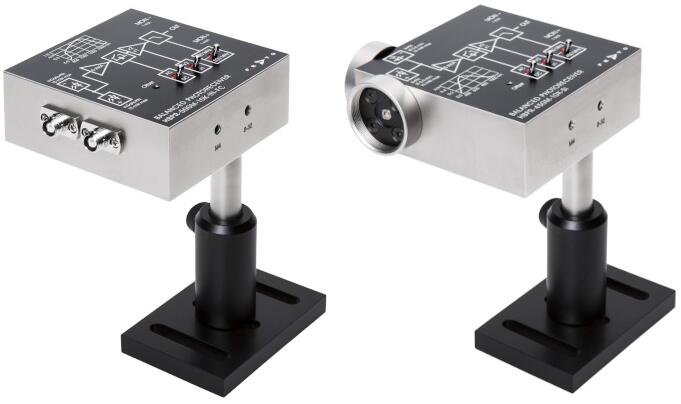Updated:2025-03-13
Views:2219
 WeChat
WeChat
 QQ
QQ
 Online Service
Online Service
Bandwidth up to 500 MHz
Common-Mode Rejection Ratio (CMRR) up to 55 dB
Low noise, NEP down to 3.7 pW/√Hz
Si and InGaAs models for spectral range from 320 to 1700 nm
Switchable 20 MHz low pass filter to minimize wideband noise
High gain of up to 60,000 V/A, switchable in two stages
Switchable output coupling (AC/DC)
Fast DC-coupled monitor outputs with 10 MHz bandwidth
Input either free space or fiber-coupled
1.035 "-40 threaded free space input, compatible with many standard optical systems
By taking the exact difference between the two input signals, common-mode noise, such as the intensity noise of the laser source used, is suppressed. This way, smallest optical signals can be extracted from the signal measurement path that would otherwise be buried in the noise.
The photoreceivers / photodetectors of the HBPR series consist of a combination of two anti-parallel connected photodiodes with a subsequent low-noise transimpedance amplifier. The photodiodes are carefully selected and matched in pairs to achieve the highest possible common mode rejection ratio (CMRR). The low input noise (NEP) and excellent common mode rejection set standards for balanced photoreceivers in the MHz range and enable highly sensitive signal detection. The high bandwidth allows the precise detection of laser pulses, even with high repetition rates and rapidly changing signal shapes, such as in quantum state tomography.
Thanks to additional features such as switchable bandwidth limitation (low-pass filter), separate fast monitor outputs, adjustable offset and switchable AC/DC coupling, HBPR series optical receiver is one of the most common balanced optical receivers.
COMPATIBLE WITH OPTICAL BENCH (FREE SPACE) AND FIBER OPTICSThe free space inputs are designed as 1.035"-40 threaded flange with screw-on coupler ring (FST) or as a 25 mm round flange without thread (FS). Both types open up broad compatibility with optical accessories from various manufacturers, such as lenses, tubes, cage systems, optical adapters etc.
The relatively large-area detectors facilitate optical focusing in free space applications and ensure high and stable coupling efficiency when using the optionally available fiber optic adapters.
The FST free space SI models with Ø 0.8 mm photodetectors can easily be converted to a fiber connection (FC, FSMA) thanks to the large detector surface, by simply screwing on optionally available fiber adapters of the PRA series. For models with smaller detector areas, such as Ø 0.4 / 0.3 mm, the use of fiber adapters is only recommended to a limited extent, since coupling losses and instabilities can occur. If the focus is on high-precision fiber optic measurements, using HBPR FC-models with fixed optical fiber input will usually give the best results.
All HBPR photoreceivers are equipped with UNC 8-32 and M4 threaded holes and can therefore be conveniently and stably integrated into optical systems on standard holders.

Pic.1 Fiber-coupled version (FC);Pic. 2 Free space version with 1.035"-40 Thread (FST);(post-holder not included in scope of delivery)
APPLICATIONSModels for the spectral range from 320 to 1000 nm:
| Model |
HBPR-100M-60K-SI-FST HBPR-100M-60K-SI-FS HBPR-100M-60K-SI-FC
|
HBPR-200M-30K-SI-FST HBPR-200M-30K-SI-FS HBPR-200M-30K-SI-FC
|
HBPR-500M-10K-SI-FST HBPR-500M-10K-SI-FS HBPR-500M-10K-SI-FC
|
|
Si-PIN photo diode |
0.8 mm Ø | 0.8 mm Ø | 0.4 mm Ø, FC version with ball lens |
|
Spectral range |
320 - 1000 nm | 320 - 1000 nm | 320 - 1000 nm |
| Bandwidth (−3 dB) | DC - 100 MHz | DC - 200 MHz | DC - 500 MHz |
| Transimpedance gain (switchable) |
2.0 x 104 V/A 6.0 ×104 V/A |
1.0 x 104V/A 3.0 ×104V/A |
5.0 x 103V/A 10.0 × 103V/A |
| Conversion gain (switchable) |
10.8 x 103 V/W typ. 32.4 x 103 V/W typ. (@ 850 nm) |
5.4 x 103 V/W typ. 16.2 x 103 V/W typ. (@ 850 nm) |
2.55 x 103 V/W typ. 5.1 x 103 V/W typ. (@ 760 nm) |
| Minimum NEP | ≤ 6.5 pW/√Hz(@850 nm) | ≤ 7.8 pW/√Hz(@850 nm) | ≤ 12 pW/√Hz(@760 nm) |
| NEP (@ 20 MHz) | ≤ 7.4 pW/√Hz(@850 nm) | ≤ 8.8 pW/√Hz(@850 nm) | ≤ 13 pW/√Hz(@760 nm) |
| Common mode rejection (typ.) | 50dB | 45dB | 40dB |
| Data sheet FS/FST version | 280kB | 280kB | 280kB |
| Data sheet FC Version | 219kB | 219kB | 219kB |
Models for the spectral range from 800 to 1700 nm:
| Model |
HBPR-100M-60K-IN-FST HBPR-100M-60K-IN-FS HBPR-100M-60K-IN-FC
|
HBPR-200M-30K-IN-FST HBPR-200M-30K-IN-FS HBPR-200M-30K-IN-FC
|
HBPR-450M-10K-IN-FST HBPR-450M-10K-IN-FS HBPR-500M-10K-IN-FC
|
|
InGaAs-PIN photo diode |
0.3 mm Ø (FS/FST model), 80 µm Ø, ball lens (FC model) | ||
|
Spectral range |
800 - 1700 nm (FS/FST model), 900 - 1700 nm (FC model) | ||
| Bandwidth (−3 dB) | DC - 100 MHz | DC - 200 MHz |
DC - 450 MHz (FS/FST) DC - 500 MHz (FC) |
| Transimpedance gain (switchable) |
2.0 x 104V/A 6.0 × 104V/A |
1.0 x 104V/A 3.0 × 104V/A |
5.0 x 103V/A 1.0 × 104V/A |
| Conversion gain @ 1550 nm (switchable) |
19 x 103 V/W typ. 57 x 103 V/W typ. |
9.5 x 103 V/W typ. 28.5 x 103 V/W typ. |
4.75 x 103 V/W typ. 9.5 x 103 V/W typ. |
| Minimum NEP (@ 1550 nm) | ≤ 3.7 pW/√Hz |
≤ 4.4 pW/√Hz (FS/FST) ≤ 4.1 pW/√Hz (FC) |
≤ 6.5 pW/√Hz (FS/FST) ≤ 6.7 pW/√Hz (FC) |
| NEP (@ 20 MHz, 1550 nm) |
≤ 4.3 pW/√Hz (FS/FST) ≤ 4.0 pW/√Hz (FC) |
≤ 4.9 pW/√Hz (FS/FST) ≤ 4.4 pW/√Hz (FC) |
≤ 6.9 pW/√Hz |
| Common mode rejection (typ.) |
≤ 50 dB(FS/FST) ≤ 55 dB(FC) |
≤ 45 dB(FS/FST) ≤ 50 dB(FC) |
35 dB(FS/FST) ≤ 45 dB(FC) |
| Data sheet FS/FST version | 272kB | 272kB | 272kB |
| Data sheet FC version | 219kB | 219kB | 215kB |
The following specifications apply to all HBPR models:
|
Max. CW common mode power |
10 mW on each photo diode |
|
Low pass filter |
Full bandwidth switchable to 20 MHz (upper cut-off frequency) |
|
High pass filter (AC coupling) |
DC coupling switchable to AC (10 Hz lower cut-off frequency) |
|
Signal output voltage |
±1.0 V at 50 Ω load (for linear gain and low harmonic distortion),maximum ±2.0 V at 50 Ω load |
|
Monitor outputs |
transimpedance gain 1000 V/A, bandwidth DC - 10 MHz, output voltage 0 ... +10 V (@ ≥100 kΩ load) |
|
Power supply voltage / current |
±15 V (±14.5 V … ±16.5 V), –90 / +120 mA typ. |
|
Housing |
80 x 80 x 30,5 mm (L x B x H), weight FC-models 350 g (0.77 lbs), weight FS/FST-models 410 g (0.9 lbs) |
Offset adjustable by potentiometer. Output short-circuit protected. Power supply via 3-pin Lemo® socket. A mating connector is provided with the device. Optional power supply PS-15 available. For further information please view the datasheet or contact FEMTO.
Customer Service QQ
Customer Hotline:
Technical Supports